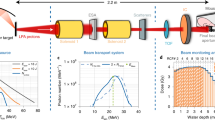Abstract
A technical set-up for irradiation of subcutaneous tumours in mice with nanosecond-pulsed proton beams or continuous proton beams is described and was successfully used in a first experiment to explore future potential of laser-driven particle beams, which are pulsed due to the acceleration process, for radiation therapy. The chosen concept uses a microbeam approach. By focusing the beam to approximately 100 × 100 μm2, the necessary fluence of 109 protons per cm2 to deliver a dose of 20 Gy with one-nanosecond shot in the Bragg peak of 23 MeV protons is achieved. Electrical and mechanical beam scanning combines rapid dose delivery with large scan ranges. Aluminium sheets one millimetre in front of the target are used as beam energy degrader, necessary for adjusting the depth–dose profile. The required procedures for treatment planning and dose verification are presented. In a first experiment, 24 tumours in mice were successfully irradiated with 23 MeV protons and a single dose of 20 Gy in pulsed or continuous mode with dose differences between both modes of 10%. So far, no significant difference in tumour growth delay was observed.




Similar content being viewed by others
References
Agostinelli S, Allison J, Amako K et al (2003) Geant4-a simulation toolkit. Nucl Instrum Methods A 506:250–303
Andreo P, Burns DT, Hohfeld K, Huq MS, Kanai T, Laitano F, Smythe VG, Vynckier S (2000) absorbed dose determination in external beam radiotherapy: an international code of practice for dosimetry based on standards of absorbed dose to water, volume 398 of technical report series (International Atomic Energy Agency)
Bortfeld T (1997) An analytical approximation of the Bragg curve for therapeutic proton beams. Med Phys 24:2024–2033
Datzmann G, Dollinger G, Goeden C, Hauptner A, Körner H, Reichart P, Schmelmer O (2001) The Munich microprobe SNAKE: First results using 20 MeV protons and 90 MeV sulfur ions. Nucl Instrum Methods B 181:20–26
Devic S, Seuntjens J, Hegyi G et al (2004) Dosimetric properties of improved GafChromic films for seven different digitizers. Med Phys 31:2392–2400
Dollinger G, Bergmaier A, Hable V, Hertenberger R, Greubel C, Hauptner A, Reichart P (2009) Nanosecond pulsed proton microbeam. Nucl Instrum Methods B 267:2008–2012
Graves EE, Zhou H, Chatterjee R et al (2007) Design and evaluation of a variable aperture collimator for conformal radiotherapy of small animals using a microCT scanner. Med Phys 34:4359–4367
Gueulette J, Slabbert JP, Böhm L et al (2001) Proton RBE for early intestinal tolerance in mice after fractionated irradiation. Radiother Oncol 61:177–184
Hertenberger R, Metz A, Eisermann Y et al (2005) The Stern–Gerlach polarized ion source for the Munich MP-tandem laboratory, a bright source for unpolarized hydrogen and helium ion beams as well. Nucl Instrum Methods A 536:266–272
ISP International Speciality Products (2009) Gafchromic EBT2 self-developing film for radiotherapy dosimetry, Rev. 1, http://online1.ispcorp.com/_layouts/Gafchromic/content/products/ebt2/pdfs/GAFCHROMICEBT2TechnicalBrief-Rev1.pdf. Accessed 1 Oct 2010
Masunaga S, Ando K, Uzawa A et al (2008) Radiobiologic significance of response of intratumor quiescent cells in vivo to accelerated carbon ion beams compared with gamma-rays and reactor neutron beams. Int J Radiat Oncol Biol Phys 70:221–228
Oelfke U, Bortfeld T (2001) Inverse planning for photon and proton beams. Med Dosim 26:113–124
Oelfke U, Nill S, Wilkens JJ (2006) Physical optimization. In: Bortfeld T, Schmidt-Ullrich R, de Neve W, Wazer DE (eds) Image-guided IMRT. Springer, Berlin, Heidelberg, pp 31–45
Rohrer L, Jakob H, Rudolph K, Skorka SJ (1984) Four gap double drift buncher at Munich. Nucl Instrum Methods A 220:161–164
Schmid TE, Dollinger G, Hauptner A, Hable V, Greubel C, Auer S, Friedl AA, Molls M, Röper B (2009) No evidence for a different RBE between pulsed and continuous 20 MeV protons. Radiat Res 172:567–574
Schmid TE, Dollinger G, Hable V, Greubel C, Zlobinskaya O, Michalski D, Molls M, Röper B (2010) Relative biological effectiveness of pulsed and continuous 20 MeV protons for micronucleus induction in 3D human reconstructed skin tissue. Radiother Oncol 95:66–72
Stojadinovic S, Low DA, Hope AJ et al (2007) MicroRT-small animal conformal irradiator. Med Phys 34:4706–4716
Szymanowski H, Oelfke U (2003) CT calibration for two-dimensional scaling of proton pencil beams. Phys Med Biol 48:861–874
Tajima T, Habs D, Yan X (2009) Laser acceleration of ions for radiation therapy. In: Chao AW, Chou W (eds) Reviews of accelerator science and technology: medical applications of accelerators, vol 2. World Scientific, Singapore, pp 201–228
Tepper J, Verhey L, Goitein M et al (1977) In vivo determinations of RBE in a high energy modulated proton beam using normal tissue reactions and fractionated dose schedules. Int J Radiat Oncol Biol Phys 2:1115–1122
van Luijk P, Faber H, Schippers JM et al (2009) Bath and shower effects in the rat parotid gland explain increased relative risk of parotid gland dysfunction after intensity-modulated radiotherapy. Int J Radiat Oncol Biol Phys 74:1002–1005
Wong J, Armour E, Kazannzides P et al (2008) High-resolution, small animal radiation research platform with X-ray tomographic guidance capabilities. Int J Radiat Oncol Biol Phys 71:1591–1599
Acknowledgments
This work has been supported by the DFG Cluster of Excellence: Munich-Centre for Advanced Photonics as well as the Maier Leibnitz Laboratorium of the Ludwig-Maximilians-Universität München and the Technische Universität München. We thank Oliver Schmalz and Katharina Schneider for their assistance in Monte Carlo treatment planning, Dr. Brill (TU München) for setting animal guidelines at the accelerator, Prof. Baumann and his radiobiological research group (TU Dresden) for FaDu cells and transplantation protocols. We also thank the technical staff of the Munich tandem accelerator.
Conflict of interest
None.
Author information
Authors and Affiliations
Corresponding author
Rights and permissions
About this article
Cite this article
Greubel, C., Assmann, W., Burgdorf, C. et al. Scanning irradiation device for mice in vivo with pulsed and continuous proton beams. Radiat Environ Biophys 50, 339–344 (2011). https://doi.org/10.1007/s00411-011-0365-x
Received:
Accepted:
Published:
Issue Date:
DOI: https://doi.org/10.1007/s00411-011-0365-x




